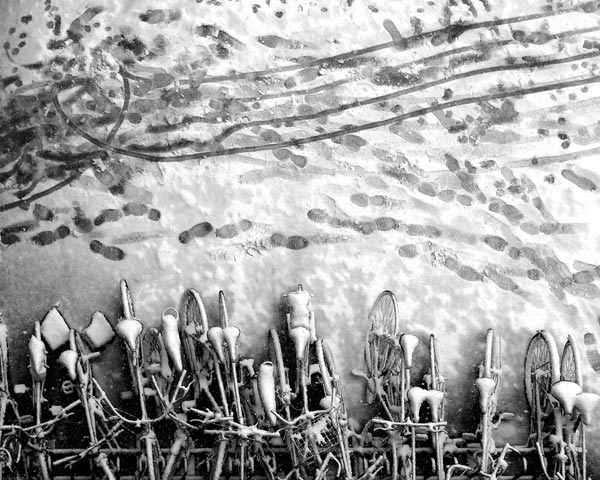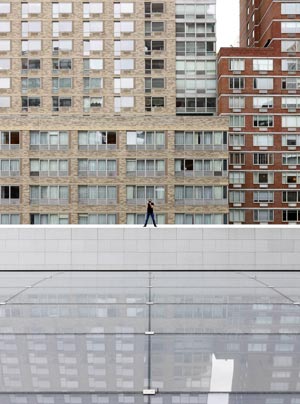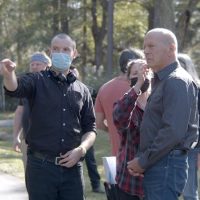
Interior design photographer Adrian Wilson is one of America's most prolific experts in visual storytelling. With an impressive career in professional photography and videograpahy, you could say Adrian is one of the 'A list', although he's too humble to admit it. Adrian's current clients are some of the world's most recognized brands including Apple, Chanel, Victoria's Secret and Architectural Digest magazine. He has a creative perspective and approach when it comes to making it big in the industry having lived his passion everyday for the past 20 years.
Today photographers and videographers share the same tools, with DSLRs becoming a format of the future for filmmaking. Adrian recently completed a time lapse short using DSLR techniques mixed with his photographer's vision which reveals the eye-catching truth about life on the New York subway. In this exclusive interview Adrian shares his passion for photography, what kinds of equipment he uses and has some great tips for aspiring photographers and filmmakers. Discover what it takes, along with some of Adrian's personal work below.
Interview with Adrian Wilson
Iain: You recently spent an hour filming a homeless man at a New York subway station. What brought this on?
Adrian: I am not sure if it is just something I am tuned into or I am very lucky but my life really is full of bizarre things. Within the last 2 weeks I was propositioned by a dwarf hooker while on a Victoria's Secret shoot in Hawaii, last night a bisexual black male stripper stood at my apt doorway and wanted to come in to chill out because it was his birthday but both his girlfriend and boyfriend were having sex and he wasn't. "I just went to a porn booth and did some coke and have a couple of bags left if I could just come round and relax at your place because I am really upset". I saw a van with the company name Seoul Glass and wondered if it was Saul Bass' blue collar Asian cousin. I found out my ex-wife's new husband went to jail for shooting his last wife and I got a random email from ABC asking if they could interview me about my work.You couldn't make it up and I love every minute of it.
New York Subway timelapse short film
So when I was on the platform of the 34th St subway on the way to go and scout a shoot, it was another of those comedic/tragic but interesting things of the day to see a guy who stands still all day like a statue asleep on the bench opposite. I loved how the family at the other end of the bench were carrying on regardless, so I took a cell phone snap. When I returned 2 hours later the busker was still asleep so I decided to get my camera and shoot the scene properly. I put the camera next to me on the bench and for the next hour pressed the shutter at random moments. I thought it would make a great series of prints but as I took it, I realized that this would make a great stop frame animation, so that's what it became. The different reactions of people that sat next to me and asked what I was shooting only added to the experience.
I love the work of Jan Švankmajer but never could understand the communist references that are woven into his work. Although my short film is incomparable in terms of talent, the political and economic resonance is very clear. One of my all time favorite movies is Midnight Cowboy. The harmonica theme plays as Joe Buck watches all the bustle around Times Square and also as Ratzo Rizzo arrives dead on the bus from NY, so it seemed a perfect match. The late John Barry is a good friend of mine's uncle and I thought it fitting as a personal memorial to a great composer.
Iain: How did you get into videography and are you doing this professionally or for the passion?
Adrian: Back in the 1980's I was the first artist to combine photography with digital graphics, using a Quantel Paintbox. I was sponsored by Fuji, and was in one of the first international exhibitions of digital art and declined when asked by WEA to work on pop videos. I am still good friends with people I met at the time including Trudy Bellinger the renowned video director who was a former EMI creative director and Emmy award winning post production artist Simon Scott. I decided sitting in front of a monitor for hours was not for me and have now been a specialist interior photographer for 25 years. I saw a couple of years ago that with the ipad, youtube and smartphones that there was going to be a shift toward video content and therefore I should look into it. The first thing I realized was that there is no composition in moving images and if there's one thing I obsess over it is good composition. Unless the camera was stationary and objects or people moved around the frame, a camera is always panning, tilting or zooming around a space. My initial plan was to start a video clip with a perfectly framed view of an interior and then move the camera across the room to end at another perfectly composed view. In practice the thing that I found was most interesting about video was the ability to walk into a room, creating a spacial "reveal". I was the first interior photographer to shoot video and so decided to learn by trial and error as that is often the best way to develop a personal style. In the last couple of years I have shot videos of interiors for the likes of Nike, Apple, Saks 5th Avenue, Victoria's Secret and Heineken.
The strange thing is that the more I shoot video, the more I am drawn into a passion for the medium. I always remember a Fred Allen 1950 quote that "Television is called a medium because it is neither rare nor well done” and I think that 60 years later, video is even more mediocre. I am really not satisfied with what I create, partly because I have had to learn a whole new language of gain, iris and other terminology but mostly because I am still learning the basics of smooth movement and editing. The constraints of being unable to easily photoshop out things like my reflections is both annoying and a fantastic challenge. I don't do things I don't like and I have always avoided photographing people but one thing video has done is introduced a human element to my work. Photography is about the split second moment in time but video really is also about the dimension of movement through the volume of space and life. My photographic skills are still nourishing my soul but I have definitely begun a journey to a new level of creativity. The important thing for me is to travel my own route.

Iain: Is there anyone who inspired your style of photography?
Adrian: It may sound strange but when I started back in the 1980s, being an interior designer was not a career anyone really thought about. There were the Doris Day movie type decorators who specified chintzy curtains and velvet cushions for ladies who lunch but that was about it. Architects may have had a guy in the corner doing the interiors and there were a few commercial designers but it was nothing like the inspirational cool career it is now. Consequently, there were no interior photographers, only architectural shooters who would use large format cameras and take 6 shots in a day. I learned my craft working freelance for a publishing company that had me shoot 2,000 bars, nightclubs, restaurants and hotels around Europe over a 13 year period. There was nobody to look up to and nobody to learn from and I would shoot about 50 images in a 4-hour period on film without using additional lights, polaroids or even a light meter.
It can be annoying if I take a shot and someone says it looks like "A Gursky" or a "Michael Wolf" because I really don't follow their work but they are really the only two photographers who have a similar compositional aesthetic and obsession to detail. To be completely honest, I have never found it of much interest what other photographers are doing apart from friends like Boogie.
Iain: What kind of equipment do you use? Do you have any preferences when it comes to lenses?
Adrian: I use a Sony HXR- NX5U video camera. A lot of people use a DSLR and I did look into it but decided to keep the two capture processes separate. I use a canon 1dsMk3 for photography with a 24mm lens, which is never removed. I am super careful about dirt on the sensor and the idea of swapping lenses and doing pans with a DSLR with dirt on the sensor seems a major headache. The fixed lens on the Sony (28-300mm) and the fact that the depth of field is so much better than on a DSLR means that it is perfect for natural light interior work
Iain: Do you have any tips for photographers looking to make a career out of the art?
Adrian: When I first looked into video, there were photographers who thought that the public would be really fascinated to see behind the scenes videos of photoshoots. Even I didn't care about that, so why be so arrogant to think that others do apart from to look at some swimsuit models messing about on set. I decided to explore video as an additional service and as we all know, the hardest part of any shoot is getting to the point when one presses the button - to record or to release the shutter. My logic was that swapping the stills camera for a video on the tripod and panning around the set was bound to result in something the client could use now or at a later date. I didn't even charge clients at the beginning, assuming it was unfair to have them pay for my travels up the steep learning curve but also allowing me to do what I wanted, not what they did. It is much better to develop a style using the photographers’ eye for composition and the way light works and then transfer that vision to video and show the client what you are happy you created. I don't storyboard at all and tend now to shoot stills first and as I am doing so plan a sequence in my head. Most clients have bought the videos I have shot, or I know they will want to at some point in the future and I have learned so much from the process that has curved right back and improved my photographic images.
Iain: Are there any upcoming projects you are working on that you can reveal?
Adrian: The subway video was about capturing an unplanned New York moment but I am currently working on documenting how people interact with their homes during a 24-hour period, which will be a mixture of stills and video. It will be the opposite of what I do for a living - making amazing spaces look even better. I want to show how we all really live, dirty dishes and feet up on the sofa, warmth and a place to be comfortable. In other words what a home really provides for us all, rather than the largely unattainable coffee table book fantasy I am partly responsible for creating. If anyone in NY would allow me to spend a day at their place documenting their life I would love to hear from you.
From Korean deli worker to Madison Avenue millionairess, it's a home life that I want to see unfold hour by hour. Otherwise I just keep my eyes open. It's a fantastic life and sometimes I think of Rutger Hauer's death scene in ‘Bladerunner’ when he says "I've seen things you little people wouldn't believe... Attack ships on fire off the shoulder of Orion bright as magnesium... I rode on the back decks of a blinker and watched c-beams glitter in the dark near the Tanhauser Gate. All those moments... they'll be gone." Although I am one of the "little people" Rutgers refers to, I am lucky that the amazing things that life showed me will never be gone. I captured them.
Adrian's Photography website: www.interiorphotography.net
(Photographs © Adrian Wilson)





















